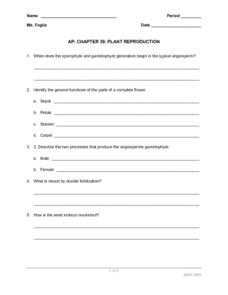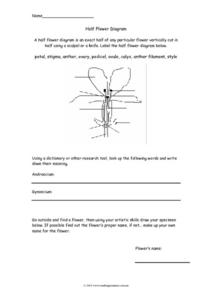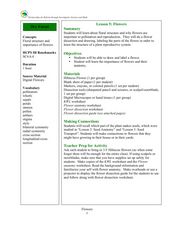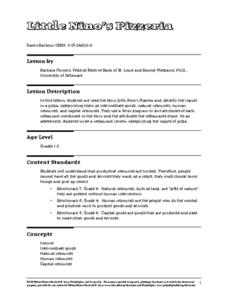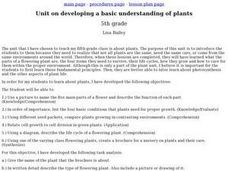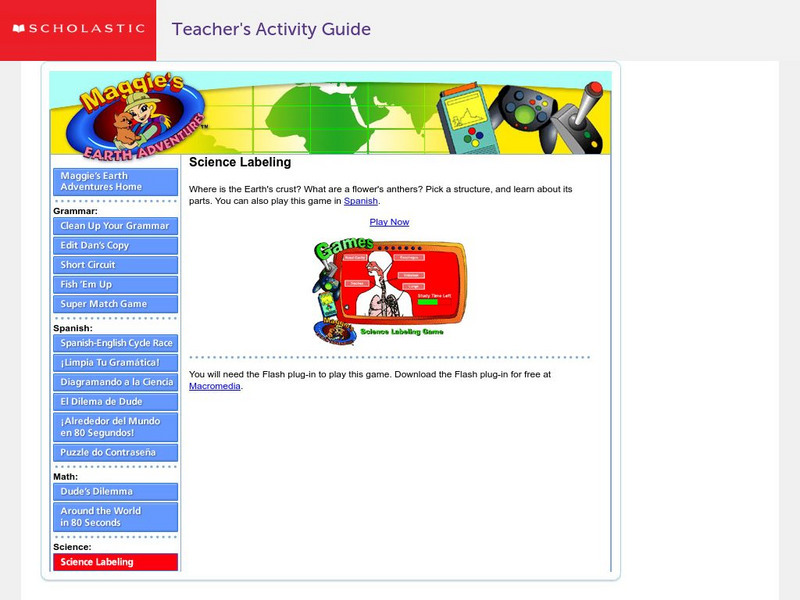Curated OER
AP: Chapter 38: Plant Reproduction
Short, but sweet, this handout questions the learner on the structures and processes of plant reproduction. Budding botanists draw a dicot seed, label a flower diagram, and describe the functions of different flower parts. It also covers...
Curated OER
Half Flower Diagram
In this half flower diagram worksheet, learners label flower parts on a "half flower" diagram, use a dictionary/research tool to write definitions for 2 given words, and draw a picture of a flower they find.
Curated OER
Flower Power
Determine which plants are flowering plants with a helpful lab sheet. Kids first observe illustrations of different plants, such as a carnation and a fern, then decide which plants produce flowers, spores, or cones. Use magazine pictures...
abcteach
Flowers for Algernon, by Daniel Keyes
Looking for materials to accompany your study of Flowers for Algernon, by Daniel Keyes? Look no further! Included here is everything you need to go alongside your unit: worksheets, graphic organizers, writing assignments, an assessment,...
Curated OER
Flowers and Their Life Cycles
First-time florists will be able to label the structures of simple and composite flowers after reading this handout and answering the comprehension questions. There are a couple of grammatical errors in the text, but the content is...
Curated OER
Leaves
In this biology worksheet, students write identify the different parts of a leaf shown in 5 different diagrams. They also complete 12 short answer questions after reading the information about leaves.
Curated OER
Dry Forest: Flowers
Students explore botany by examining diagrams. In this plant reproduction activity, students define a list of plant vocabulary terms and identify plant anatomy from a diagram. Students complete several plant activity worksheets and study...
Pearson
Flowering Plants
In this plants worksheet, students name and locate the major organs of flowering plants. Then students color, cut and paste a flower model by following the directions given.
Curated OER
Pollination
In this pollination worksheet, students read and assess comprehension. In this labeling and filling in the blanks worksheet, students answer fourteen questions.
Curated OER
Let's Learn About Plants!
Students discover different plants and plant parts by observing their campus. In this plant life lesson, students take a guided walk around their school with a magnifying glass examining everyday plants as well as photographing...
Houghton Mifflin Harcourt
That’s Amazing!: Challenge Activities (Theme 3)
Synonym dominoes, anyone? As part of the activities designed for kids who have mastered the basic concepts in the Houghton Mifflin Harcourt thematic unit That's Amazing! kids are offered a variety of activities that include...
Curated OER
Adverb or Adjective
Sixth graders choose adjectives to describe an object given by the teacher and share with the class, then do the same for a verb, choosing an adverb to modify each. In this adjective or adverb lesson, 6th graders review the difference...
Curated OER
Insects Are Helpful!
Students see that insects do lots good and are very valuable to humans and nature. This is part of an ongoing effort to dispel fears of insects. They rotate through a series of centers that have examples of how insects contribute to our...
Curated OER
Trait Variations for Survival
Young learners examine how different traits could give one organism an advantage over another. In groups, they view two different organisms in different environments. To end the lesson, they complete a Venn Diagram on the two organisms...
Curriculum Corner
Coniferous and Deciduous Trees
What are the differences between coniferous and deciduous trees? Supplement your tree lessons with a set of activities that has learners describing, naming, comparing, and reading about deciduous and coniferous trees. The activities are...
Federal Reserve Bank
Little Nino's Pizzeria
Engage your youngsters in basic economics by connecting the terms to dessert and pizza! After a discussion about intermediate goods and natural resources, learners read and connect a pizzeria to economic terms.
Curated OER
Unit on Developing a Basic Understanding of Plants
Fifth graders study the parts of a plant, their life cycles, and how to care for them in this unit.
Curated OER
The Joy of a Garden-Earth Day
Students explore the purpose of a garden. In this Earth Day lesson plan, students read the story The Gardener and complete a Venn diagram comparing life in a city to farm life. Students discuss Earth Day and plant flowers in a garden .
Curated OER
Life Cycle of Brassica Plants: Planting Seeds
Students explore botany by participating in a calendar class activity. In this plant observation lesson, students examine a diagram of a Brassica plant and identify its anatomy before planting their own seeds and viewing the changes over...
Bethel School District
Observations and Inference
What's the difference between qualitative and quantitative observations? Learners make observations, inferences, and predictions about their environment with a set of questions and activities that are applicable to either language...
Curated OER
Writing the Essay
Relate the structure of the essay to the structure of a building. The class compares an essay to a building, with the writer being the architect, the introduction being the foundation, and so on. They use the visual representation of a...
Scholastic
Scholastic: Science Labelling Game
In a series of five interactive science games, students first study labeled diagrams to learn the names of the Earth's layers, of a flower's parts, of a fish's anatomy, of the human respiratory system, and of layers of the atmosphere....
